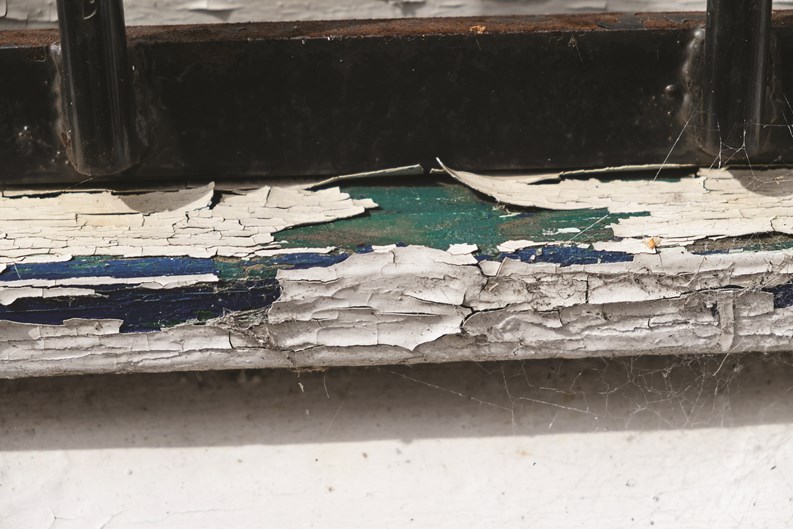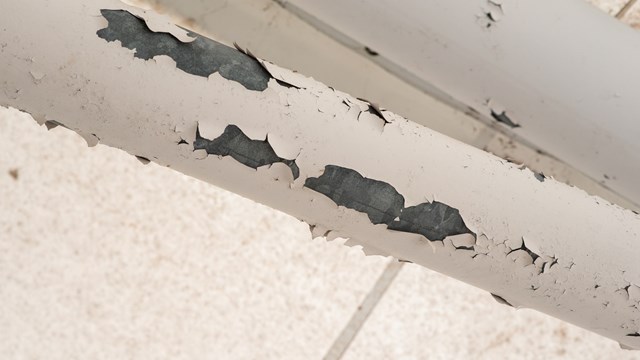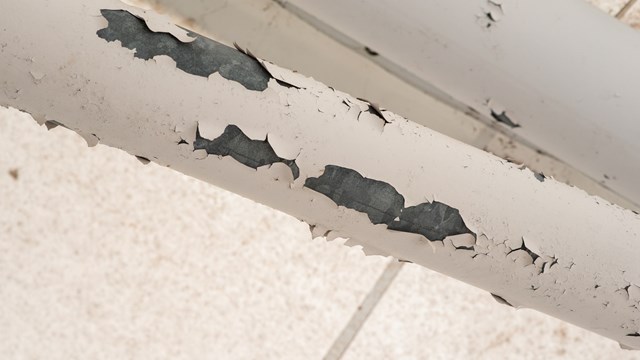In New York, with its countless multifamily buildings, there are certain dangers that have nothing to do with crime rates, economics, or the latest exotic imported disease. Falling bricks, short circuits leading to fires, trash piling up, and uneven, cracked pavements that present a tripping hazard can all do just as much damage to life and limb— but there can be other dangers that are not that obvious. Things like lead paint, mold, asbestos, carbon monoxide, and formaldehyde can be harmless under normal circumstances, but become dangers when they are exposed, or when they accumulate in a residential setting.
Not all buildings have these problems. And hopefully, your own co-op or condo board is informed and aware of the risks and how to mitigate them. If not, you may want to have your unit inspected.
A Rogue’s Gallery of Toxins
When it comes to indoor environmental hazards, one of the major culprits is lead paint. Used mainly in older buildings, it was banned in New York City in the early 1960s when lead paint chips were linked to developmental delays, behavioral issues, and other serious health problems for babies and young children. (Lead paint was used in other areas of the country until the late ‘70s.) Even when it’s been painted over with layers of newer, lead-free paint, lead paint poses a threat when it’s disturbed — either through cracking/chipping, or during any kind of remodeling or maintenance that causes lead-carrying dust or particles to be exposed or made airborne.
“In its heyday, lead paint was promoted as the wonder paint,” says Lee Wasserman, president of the LEW Corporation, an environmental consulting firm based in Mountainside, New Jersey. “It had good durability, it would kill fungi. Homes that were built before 1950 have a 69 percent probability of having lead somewhere inside them. Those that were built between 1950 and the ‘60s, it’s 30 percent, and from 1960 to ’70, it dramatically drops off.”
Another very common substance that raises alarm bells in a residential setting is asbestos. Asbestos was widely used as a fire retardant until the late 1970s, although reports that it caused illness were issued as early as the 1920s. To this day, you can find older wooden houses with asbestos shingles.
In most apartment houses, asbestos was used as insulation and is under the surface. But when renovation or construction work exposes the asbestos, it becomes a serious problem. Like lead paint, asbestos was considered state-of-the-art and was legal to use in the past, says Jennifer Carey, president of JLC Environmental Consultants, Inc., in Manhattan. Both substances “were applied with good intentions, but now must be removed according to regulations governing this process.”
A third—and even more common— indoor environmental offender is mold. “Mold spores are everywhere — they’re in every room of your house,” says William Kerbel, president of Environmental Health Investigations Inc., in Sparta, New Jersey. “Mold isn’t really the problem. Water is the problem.” Water leakage or standing water can cause the spores to grow into actual mold.
Another serious concern—particularly in suburban areas and garden apartments —is radon. It is an invisible, odorless gas that occurs naturally as part of the decay of radium and uranium under the ground. Under certain circumstances it can seep into a home, poisoning and even killing pets and humans.
Often, the type of material the house is built on affects the risk factor. “If a community is built on clay-based ground,” says Wasserman, “there isn’t so much of a radon problem because the clay forms a barrier. But maybe a block away, where houses are built on shale stone, which has a lot of cracks and fissures, the gas begins to rise.” He adds that garden-style apartments have a lower probability of hazardous substances —they tend to have aluminum windows, metal door frames and a sheetrock interior. Indoor air quality issues, he says, are often found in high-rises because of systems that recirculate the air.
Lead, asbestos and radon aren’t the only hazardous materials one can find in the home, of course. Everyone knows the deadly effects of carbon monoxide, which is why many municipalities require carbon monoxide detectors in apartment buildings as well as smoke detectors, and even the very materials your building or unit is built out of can cause trouble. Some treated wood products, like pressed wood, can give off formaldehyde vapors, says Richard Lester, president of Garden State Environmental in Glen Rock, New Jersey. Formaldehyde can cause irritation of the skin, eyes, nose and throat — and worse — in high enough concentrations.
Less common but also very problematic are pollutants from underground fuel oil tanks. Let’s say a gas station has underground tanks to store the fuel it sells. The station goes out of business, the land is vacant for 10 or 20 years, and the presence of the tank is forgotten. Then, when a developer buys the land and wants to develop, they suddenly find out about the potentially- dangerous issue.
Most Common Toxins
Which toxins your community should be most concerned and vigilant about depends largely on your location and the type of building you’re dealing with. For example, Joshua Sarett, president and CEO of ALC Environmental, which has offices in Manhattan and Philadelphia, says that “The most common calls we receive from property managers and tenants in New York City are for lead, asbestos and mold. In suburban areas, the most common calls are for mold. We get calls for radon usually at the time of purchase of a new home.”
Carey concurs. “As consultants, we find the most common environmental issues that arise in residential real estate are usually lead-based paint, asbestos-containing materials and mold contamination from water intrusion problems,” she says, adding that suburban areas tend to have similar issues, although “one item that is found more often in the suburbs is radon. One of our clients buying a piece of residential property in Tennessee found elevated rates of radon at the site, and walked away from the deal because of those levels.”
Lead paint and asbestos, of course, are mainly found in older buildings. Newer buildings, says Sarett, “have issues with indoor air quality, especially mold.”
Aside from the type of building, the surrounding area is also a risk factor. Traffic, exhaust, nearby construction sites or nearby hazardous waste sites nearby can impact danger inside the building, says Lester. Groundwater under a building can also cause contamination.
How They Get In
Some of the materials we’ve mentioned—lead paint, asbestos, formaldehyde — aren’t invaders from afar; chances are they were included in the building’s initial construction. In addition to paint on the walls, lead can also come from water pipes — lead pipes, and lead soldering to connect copper pipes, were used into the ‘70s. The old idea of running water from the kitchen tap for a few seconds “to get the lead out” turns out not be such an old wives’ tale after all.
“There has been a greater increase in determining the presence of lead in water since the Flint, Michigan, incident,” says Sarett. In that city, after officials switched the source of the municipality’s drinking water from Lake Huron to the highly corrosive Flint River and didn’t use an anti-corrosive agent, tests showed alarming levels of lead in local households.
Other substances come from outside. For example, we’ve already talked about radon gas coming from underground, and mold being formed by water leaks and standing water, but carbon monoxide also gets in from the outside. “We have been called in to projects,” says Carey, “where CO is being emitted from the building’s parking facility where cars are left idling. CO can also be a byproduct of an inefficient boiler or other heating system. CO is known to cause headaches, dizziness, weakness and confusion, and can often be fatal.”
How Harmful Are They?
The substances we’ve mentioned can have serious health effects. Prolonged exposure to lead, for example, can result in weight loss, loss of appetite, vomiting, constipation, hearing loss, developmental delays in children, a decline in children’s IQ, high blood pressure and more.
Prolonged exposure to asbestos can result in shortness of breath, scarring of the lungs and, in some cases, lung cancer. For this reason, asbestos workers wear heavy, body-encasing protective suits to prevent them from inhaling the mineral fibers. And mold can exacerbate allergies and upper respiratory problems in people who have them, and cause them in people who haven’t had them in the past. As one might expect, certain groups are more at risk than others. These include young children, the elderly, and people with compromised immune systems, such as those suffering from AIDS or other immunosuppressive illnesses, or recovering cancer patients who are receiving chemotherapy, according to Kerbel.
Is socioeconomic status a reliable indicator of vulnerability to hazardous substances? Not necessarily, says Wasserman. “As a whole, lower-income people tend to live in older housing stock that isn’t always maintained, and maybe you have more children who aren’t being watched. But I get just as many legal cases [in my capacity as an expert witness] from upper-income people. I have a case of someone who was a medical intern in a prestigious hospital who got exposed in his house in Scarsdale.”
Further complicating the issue of indoor toxin exposure is the fact that while some of these substances act quickly on the body, triggering symptoms of exposure, others can build up in the body for years before their effects become apparent. Exposure to asbestos “is a disease with a long latency period that can take 10 to 40 years to show up as asbestosis or mesothelioma,” says Carey. On the other hand, “lead paint is an acute toxin that shows up in your blood levels in a short period of time after exposure.” This is why young children are often tested for lead levels in the bloodstream.
Legislation and Regulations
Hazardous substances in buildings are regulated by an assortment of federal, state and local statutes and ordinances. For example, the federal Environmental Protection Agency (EPA) establishes standards for risk abatement for lead paint. Asbestos is highly regulated at the federal level because of the passage of laws like the Asbestos Hazard Emergency Response Act, the Asbestos Information Act and the Asbestos School Hazard Abatement Reauthorization Act.
New York City’s Department of Environmental Protection has stringent rules about the process of removing asbestos from buildings, covering the entire process from licensing and certification to procedure to workplace conditions. The city’s Local Law 1 of 2004 requires landlords or co-op/condo boards to identify and remediate lead paint-based hazards in older buildings, especially when a child under the age of six lives in an apartment. And just this year, New York State’s mold law took effect, requiring training, certification and minimum work standards for professionals involved in mold removal.
Regulations and legislation can vary from state to state. “New York and California are the most aggressive states [in regulating indoor hazards],” says Kerbel. “Many other states have very little regulation.”
The Ins and Outs of Removal
What happens if a building is found to be riddled with toxic or hazardous materials? While there are self-testing kits that can alert you to the presence of some materials, there are regulations in place for the safe removal of these environmental toxins. “It’s best to hire licensed consultants and contractors to perform the work,” says Sarett.
Lester of Garden State Environmental tells how he, as a consultant, handles mold. “Mold,” he says, “requires a history of what’s occurred in the unit, understanding what the sources of water are, what material got wet, and any visible areas of mold growth. We take moisture measurements, and based on that, we come up with a recommended protocol. The building gets a qualified remediator to do the work — we’re not a remediator — and then we do a post-remediation inspection. The same general theme applies to other hazards.”
If there is a building-wide problem or problem in a building’s common areas, it’s the board’s responsibility to tell the shareholders or the unit owners. This can be done by written notification, at a special board meeting, or at the annual meeting, depending on the circumstances.
Thankfully, boards and managers have many resources for information about hazardous substances. Many companies like the ones interviewed for this article provide valuable facts and hints. For example, JLC’s website, jlcenvironmental.com, has answers to frequently asked question about lead, mold and asbestos. ALC, for its part, regularly holds “environmental boot camps” to educate, train and advise.
Also valuable are the EPA’s website, www.epa.gov; the state Department of Health, https://www.health.ny.gov/; the city’s Department of Health and Mental Hygiene, http://www1.nyc.gov/site/doh/index.page; the Indoor Air Quality Association http://www.iaqa.org/ and more.
Ranaan Geberer is a freelance writer and reporter and a regular contributor to The Cooperator.










Leave a Comment